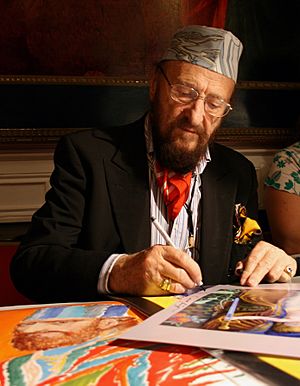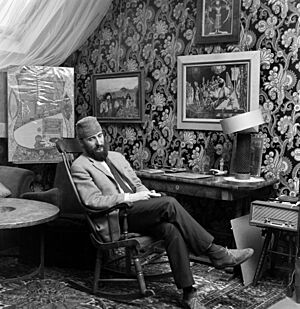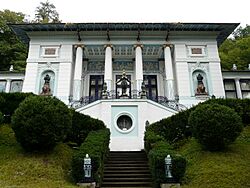Ernst Fuchs (artist) facts for kids
Ernst Fuchs (born February 13, 1930 – died November 9, 2015) was a very talented Austrian artist. He was a painter, sculptor, and even designed stages for plays. He also helped start a special art group called the Vienna School of Fantastic Realism. In 1972, he bought an old house, the Otto Wagner Villa. He fixed it up and turned it into the Ernst Fuchs Museum in 1988.
Contents
Becoming an Artist
Ernst Fuchs was born in Vienna, Austria. He was the only child of Maximilian and Leopoldine Fuchs. When he was young, he went to the St. Anna Painting School in 1944. There, he learned from an artist named Fritz Fröhlich.
In 1945, Ernst Fuchs went to the Academy of Fine Arts Vienna. He first studied with Professor Robin Christian Andersen. Later, he moved to the class of Albert Paris von Gütersloh.
Starting a New Art Style
At the Academy, Ernst Fuchs met other young artists. These included Arik Brauer, Rudolf Hausner, and Wolfgang Hutter. Together, they created a new art movement. It became known as the Vienna School of Fantastic Realism. This group focused on art that was imaginative and dream-like.
Fuchs was also a founding member of the Art-Club in 1946. Later, he helped start another group called the Hundsgruppe in 1951. He formed this group with Friedensreich Hundertwasser and Arnulf Rainer.
Artistic Influences and Techniques
In his early years, Fuchs was inspired by artists like Gustav Klimt and Egon Schiele. He also looked at the works of Max Pechstein and Edvard Munch.
Fuchs wanted to make his paintings glow with bright light. He studied old masters like Albrecht Dürer. To get these effects, he brought back an old painting method. It was called the mischtechnik (mixed technique). In this method, artists use egg tempera to build up shapes. Then, they add layers of oil paints mixed with resin. This makes the painting look like a sparkling jewel.
Life and Work Abroad
From 1950 to 1961, Fuchs lived mostly in Paris, France. He also traveled to the United States and Israel. During this time, he enjoyed reading about spiritual ideas. He also studied the meaning of symbols used by alchemists. He was very interested in the art style called mannerism. Artists like Jan van Eyck also influenced him.
In 1958, he opened the Galerie Fuchs-Fischoff in Vienna. This gallery helped new artists from the Fantastic Realism movement. He also co-founded the Pintorarium with Friedensreich Hundertwasser and Arnulf Rainer.
Spiritual Journey and Art
When he was 12 years old, Ernst Fuchs became a Catholic. His mother had him baptized during World War II. This was to help protect him during the war.
In 1957, he went to the Dormition Abbey in Jerusalem. There, he started working on a large painting called Last Supper. He also painted many smaller religious artworks. These included scenes like Moses and the Burning Bush. He was also asked to paint three altar paintings for a church in Vienna. These were called the Mysteries of the Holy Rosary (1958–61).
The Ernst Fuchs Museum
Fuchs returned to Vienna in 1961. He had an idea for a "Hidden Prime of Styles" in art. He wrote about this idea in his book Architectura Caelestis: Die Bilder des verschollenen Stils. He also created many important print series. These included Unicorn (1950–52) and Samson (1960–64).
In 1972, he bought the old Otto Wagner Villa in Hütteldorf. It was in bad shape, but he fixed it up. He turned it into a beautiful space. In 1988, the villa officially opened as the Ernst Fuchs Museum.
From 1970 onwards, Fuchs also started making many sculptures. One famous sculpture is Queen Esther (1972). It stands at the entrance to his museum. Another version is on a car at the Dalí Museum in Spain.
Designing for Stage and More
Starting in 1974, Fuchs began designing stage sets and costumes. He worked on operas by famous composers like Mozart and Richard Wagner. Some of these operas included Die Zauberflöte and Parsifal.
In the 1970s, he also tried industrial design. He decorated a special set of Suomi tableware. This was for a German porcelain company called Rosenthal.
In 1993, a big exhibition of Fuchs's art was held. It was at the State Russian Museum in St. Petersburg. He was one of the first Western artists to be honored in this way.
Family Life
Ernst Fuchs had 16 children. He believed that monarchy was a better form of government. His son Emanuel shared this after his father passed away.
Ernst Fuchs died in Vienna on November 9, 2015. He was 85 years old.
Awards and Honors
- 1972: City of Vienna Prize for Visual Arts
- 2009: Austrian Cross of Honour for Science and Art, 1st class
- 2010: Golden Medal of Honour for Services to the city of Vienna
See also
- Fantastic Realism School of art
- Visionary Art





